
In astronomy, stellar classification is the classification of stars based on their spectral characteristics. Electromagnetic radiation from the star is analyzed by splitting it with a prism or diffraction grating into a spectrum exhibiting the rainbow of colors interspersed with spectral lines. Each line indicates a particular chemical element or molecule, with the line strength indicating the abundance of that element. The strengths of the different spectral lines vary mainly due to the temperature of the photosphere, although in some cases there are true abundance differences. The spectral class of a star is a short code primarily summarizing the ionization state, giving an objective measure of the photosphere's temperature.
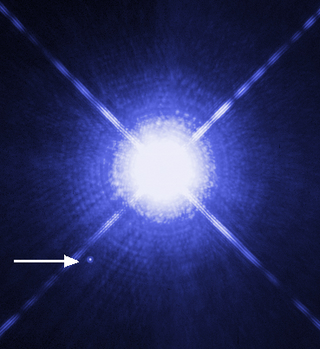
A white dwarf is a stellar core remnant composed mostly of electron-degenerate matter. A white dwarf is very dense: its mass is comparable to the Sun's, while its volume is comparable to Earth's. A white dwarf's low luminosity comes from the emission of residual thermal energy; no fusion takes place in a white dwarf. The nearest known white dwarf is Sirius B, at 8.6 light years, the smaller component of the Sirius binary star. There are currently thought to be eight white dwarfs among the hundred star systems nearest the Sun. The unusual faintness of white dwarfs was first recognized in 1910. The name white dwarf was coined by Willem Luyten in 1922.
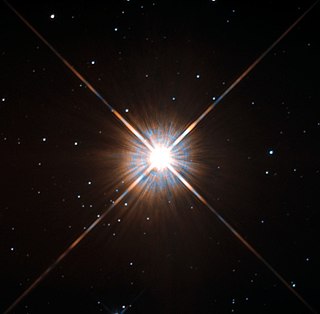
A red dwarf is the smallest and coolest kind of star on the main sequence. Red dwarfs are by far the most common type of star in the Milky Way, at least in the neighborhood of the Sun. However, individual red dwarfs cannot be easily observed as a result of their low luminosity. From Earth, not one star that fits the stricter definitions of a red dwarf is visible to the naked eye. Proxima Centauri, the nearest star to the Sun, is a red dwarf, as are fifty of the sixty nearest stars. According to some estimates, red dwarfs make up three-quarters of the stars in the Milky Way.

A G-type main-sequence star, also often, and imprecisely called a yellow dwarf, or G star, is a main-sequence star of spectral type G. Such a star has about 0.9 to 1.1 solar masses and an effective temperature between about 5,300 and 6,000 K. Like other main-sequence stars, a G-type main-sequence star converts the element hydrogen to helium in its core by means of nuclear fusion, but can also fuse helium when hydrogen runs out. The Sun, the star in the center of the Solar System to which the Earth is gravitationally bound, is an example of a G-type main-sequence star. Each second, the Sun fuses approximately 600 million tons of hydrogen into helium in a process known as the proton–proton chain, converting about 4 million tons of matter to energy. Besides the Sun, other well-known examples of G-type main-sequence stars include Alpha Centauri, Tau Ceti, and 51 Pegasi.
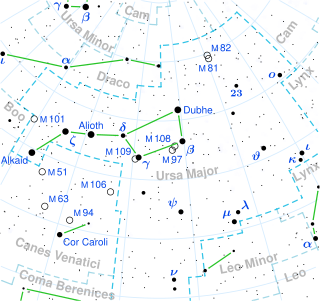
Groombridge 1830 is a star in the constellation Ursa Major.

Sigma Draconis is a single star in the northern constellation of Draco. It has the proper name Alsafi, while Sigma Draconis, which is latinised from σ Draconis and abbreviated Sig Dra or σ Dra, is the Bayer designation. It has an apparent visual magnitude of 4.7, which is bright enough to be faintly visible to the naked eye. Based on parallax measurements, this star is located at a distance of 18.8 light years from the Sun. It is receding from the Sun with a radial velocity of 26.6 km/s.

An F-type main-sequence star is a main-sequence, hydrogen-fusing star of spectral type F and luminosity class V. These stars have from 1.0 to 1.4 times the mass of the Sun and surface temperatures between 6,000 and 7,600 K.Tables VII and VIII. This temperature range gives the F-type stars a whitish hue when observed by the atmosphere. Because a main-sequence star is referred to as a dwarf star, this class of star may also be termed a yellow-white dwarf. Notable examples include Procyon A, Gamma Virginis A and B, and KIC 8462852.

An A-type main-sequence star or A dwarf star is a main-sequence star of spectral type A and luminosity class V (five). These stars have spectra defined by strong hydrogen Balmer absorption lines. They measure between 1.4 and 2.1 solar masses (M☉) and have surface temperatures between 7,600 and 10,000 K. Bright and nearby examples are Altair (A7), Sirius A (A1), and Vega (A0). A-type stars do not have convective zones and thus are not expected to harbor magnetic dynamos. As a consequence, because they do not have strong stellar winds, they lack a means to generate X-ray emissions.

A B-type main-sequence star is a main-sequence (hydrogen-burning) star of spectral type B and luminosity class V. These stars have from 2 to 16 times the mass of the Sun and surface temperatures between 10,000 and 30,000 K. B-type stars are extremely luminous and blue. Their spectra have strong neutral helium absorption lines, which are most prominent at the B2 subclass, and moderately strong hydrogen lines. Examples include Regulus and Algol A.

Pi3 Orionis (π3 Orionis, abbreviated Pi3 Ori, π3 Ori), also named Tabit, is a star in the equatorial constellation of Orion. At an apparent visual magnitude of 3.16, it is readily visible to the naked eye and is the brightest star in the lion's hide (or shield) that Orion is holding. As measured using the parallax technique, it is 26.32 light-years (8.07 parsecs) distant from the Sun.
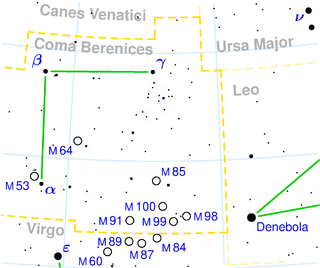
Beta Comae Berenices is a main sequence dwarf star in the northern constellation of Coma Berenices. It is located at a distance of about 29.95 light-years from Earth. The Greek letter beta (β) usually indicates that the star has the second highest visual magnitude in the constellation. However, with an apparent visual magnitude of 4.3, this star is actually slightly brighter than α Comae Berenices. It can be seen with the naked eye, but may be too dim to be viewed from a built-up urban area.
109 Piscium is a yellow hued G-type main-sequence star located about 108 light-years away in the zodiac constellation of Pisces. It is near the lower limit of visibility to the naked eye with an apparent visual magnitude of 6.27. The star is moving closer to the Earth with a heliocentric radial velocity of −45.5 km/s. It has one known exoplanet.
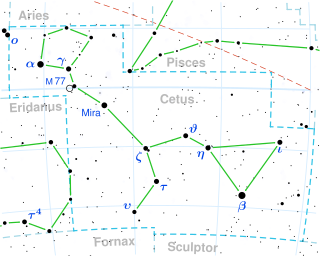
Kappa1 Ceti, Latinized from κ1 Ceti, is a variable yellow dwarf star approximately 30 light-years away in the equatorial constellation of Cetus.
61 Ursae Majoris, abbreviated 61 UMa, is a single star in the northern circumpolar constellation of Ursa Major. It has a yellow-orange hue and is dimly visible to the naked eye with an apparent visual magnitude of 5.35. The distance to this star is 31.2 light years based on parallax, and it is drifting closer with a radial velocity of −5.2 km/s. The star has a relatively high proper motion traversing the sky at the rate of 0.381″ yr−1.
Gliese 832 is a red dwarf of spectral type M2V in the southern constellation Grus. The apparent visual magnitude of 8.66 means that it is too faint to be seen with the naked eye. It is located relatively close to the Sun, at a distance of 16.2 light years and has a high proper motion of 818.16 milliarcseconds per year. Gliese 832 has just under half the mass and radius of the Sun. Its estimated rotation period is a relatively leisurely 46 days. The star is roughly 6 billion years old.

An O-type main-sequence star is a main-sequence star of spectral type O and luminosity class V. These stars have between 15 and 90 times the mass of the Sun and surface temperatures between 30,000 and 50,000 K. They are between 40,000 and 1,000,000 times as luminous as the Sun.

A red giant is a luminous giant star of low or intermediate mass in a late phase of stellar evolution. The outer atmosphere is inflated and tenuous, making the radius large and the surface temperature around 5,000 K or lower. The appearance of the red giant is from yellow-white to reddish-orange, including the spectral types K and M, sometimes G, but also class S stars and most carbon stars.

K-type main-sequence stars, also known as orange dwarfs, may be candidates for supporting extraterrestrial life. These stars are known as "Goldilocks stars" as they emit enough radiation in the non-UV ray spectrum to provide a temperature that allows liquid water to exist on the surface of a planet; they also remain stable in the main sequence longer than the Sun by burning their hydrogen slower, allowing more time for life to form on a planet around a K-type main-sequence star. The planet's habitable zone, ranging from 0.1–0.4 to 0.3–1.3 astronomical units (AU), depending on the size of the star, is often far enough from the star so as not to be tidally locked to the star, and to have a sufficiently low solar flare activity not to be lethal to life. In comparison, red dwarf stars have too much solar activity and quickly tidally lock the planets in their habitable zones, making them less suitable for life. The odds of complex life arising may be better on planets around K-type main-sequence stars than around Sun-like stars, given the suitable temperature and extra time available for it to evolve. Some planets around K-type main-sequence stars are potential candidates for extraterrestrial life.

The theorized habitability of red dwarf systems is determined by a large number of factors. Modern evidence indicates that planets in red dwarf systems are unlikely to be habitable, due to their low stellar flux, high probability of tidal locking and thus likely lack of magnetospheres and atmospheres, small circumstellar habitable zones and the high stellar variation experienced by planets of red dwarf stars, impeding their planetary habitability. However, the ubiquity and longevity of red dwarfs could provide ample opportunity to realize any small possibility of habitability.

















